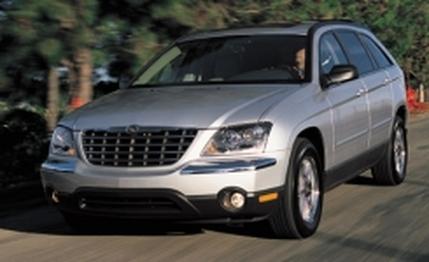
 First Drive Review
First Drive Review
Think of the Pacifica as the product of wildcat drilling. Oil explorers map out existing wells, edge out into the maybe zone nearby, then send down the drill. Maybe they'll hit a better spot in an existing underground pool. Or maybe dust. Picking the right spot is everything.
DaimlerChrysler looked at minivans, which amount to a constant stream of sales, and at SUVs, which represent a still growing torrent. It remembered back to the three-row station wagons of Ozzie and Harriet's America. And it said, "Hmm, let's drill a few short steps to the wagon side of the minivan-SUV pool."
It hit the Pacifica. Will this be a gusher? It sure doesn't have to be. Just 25 percent of Ford's Explorer volume-about 100,000 sales a year-would sell out the factory when it goes on sale this spring.
Why would you buy it? Maybe you're hoping for a minivan with less of the mommymobile stigma. Or maybe you've finally realized you're never going off-road in your SUV, so why not have something more agile for the road? Or maybe you just like new ideas. The Pacifica amounts to a rebalancing of light-truck attributes, away from boonie-bashing off-road ruggedness and toward confident handling and passenger comfort. Officially, it's still a light truck, not a car.
It's a big hunk of a truck. A wide one, too. Compared with the company's biggest minivan, the Town & Country, the Pacifica is nearly as large, only 1.7 inches shorter, on a wheelbase that's three inches less. And it's lower and wider. The roofline is down 2.4 inches; front track width is up three inches. The Pacifica has stance. In contrast with the tall-and-tippy look of SUVs and minivans, the Pacifica's lower, broad-beamed shape promises stability.
Inside, the emphasis is on people hauling. The packaging will seem familiar to boomers who grew up in a Country Squire family (for those too young to remember, that was Ford's three-row wagon clad in woody wallpaper). But the Pacifica's interior trim suggests a higher point on the price ladder. The front four seats are the first-class section, with nicely shaped buckets and plenty of knee- and elbowroom. A console runs down the center, starting at the dash and continuing back far enough to separate 2A and 2B. The third row has adult-size space, too, although headroom is limited; six-footers won't be happy. As in those family wagons of yore, rows two and three fold flat for utility hauling-flat, but not level. The load floor ramps notably upward toward the front, so watch how you stow that drink bottle!
DaimlerChrysler offered three preproduction samples for our evaluation. The company seems to have overcome the plasticky look that cheapened LH interiors. The Pacifica is smartly done up, with highly legible, illuminated-in-daylight instruments and a sense of quality about it. Too bad about the "alumathetic" plastic panels, though, which simulate aluminum bars on the doors and dash but reflect glare into the driver's eyes. Abandoned Oldsmobile buyers will find a home here.
Okay, already, you keep asking, "Is this a minivan or an SUV?"
DaimlerChrysler desperately wants you, us, and everybody with 30-some thousand to spend for a new car to certify the Pacifica as free of the practical-pig taint associated with minivans. We like minivans, and, sorry, DC, we think the Pacifica is a minivan, albeit with an exceptionally comfortable interior and pleasingly athletic handling.